Cat lovers around the globe are captivated by the sheer diversity of feline appearances. From sleek ebony panthers to fluffy gingerballs, each cat boasts a unique charm. But have you ever wondered what genetic magic conjures up this kaleidoscope of colors and patterns? It turns out, the secret lies in a surprisingly simple genetic code. Believe it or not, at their core, all cats are fundamentally either black or orange!
Think of cat coat genetics like a sophisticated photo editing app. A few key genes act as filters and modifiers, working on a basic “canvas” of black or orange to create the stunning variety we adore. Let’s dive into the fascinating world of feline genetics to understand how your beloved kitty got their gorgeous coat.
The Foundation: Black and Orange
It might sound unbelievable, but it’s true: there are only two base pigments in cat coats: black and orange. Every other color and pattern is derived from these two!
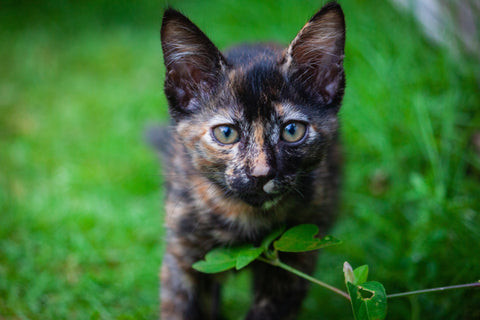 A close-up shot of a black and white cat's face, showcasing its green eyes and contrasting fur.
A close-up shot of a black and white cat's face, showcasing its green eyes and contrasting fur.
Most cats display either black-based colors or orange-based colors. The exception? The captivating tortoiseshell cat, which showcases both orange and black. This unique combination occurs because the gene responsible for orange or black color is located on the X chromosome. Female cats, with their two X chromosomes (XX), can inherit one X chromosome carrying the orange gene and another carrying the black gene. This results in the beautiful mosaic pattern of tortoiseshells.
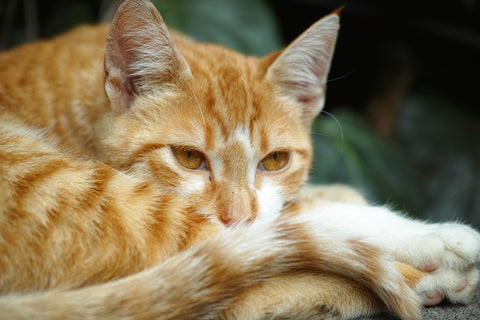 A tortoiseshell cat lying on a wooden surface, displaying its mottled coat of black, orange, and brown hues.
A tortoiseshell cat lying on a wooden surface, displaying its mottled coat of black, orange, and brown hues.
Male cats, possessing only one X chromosome (XY), can only inherit either the orange or black gene, not both. Therefore, almost all tortoiseshell cats are female. Rare exceptions, tortoiseshell males, are due to genetic anomalies, often involving an extra X chromosome (XXY).
Interestingly, orange cats are more frequently male. Approximately 80% of ginger cats are boys! This is because a male cat only needs to inherit one orange-carrying X chromosome to become orange. A female cat, however, needs to inherit the orange gene on both of her X chromosomes to display an orange coat.
Since the orange gene is less common than the black gene, it’s statistically less likely for a female cat to inherit two orange X chromosomes. For a female to be orange, she would either need two orange parents (guaranteeing orange kittens) or an orange father and a tortoiseshell mother. In the latter scenario, she would have a 50% chance of being orange and a 50% chance of being tortoiseshell.
In essence, due to statistical probability, orange coloration is more common in male cats. So, the majority of ginger felines you encounter are likely to be male!
Solid Cat Colors: Beyond Black and Orange
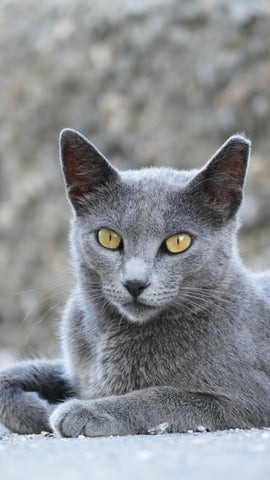 A close-up of a grey cat's face, showcasing its solid, uniform coat color and expressive eyes.
A close-up of a grey cat's face, showcasing its solid, uniform coat color and expressive eyes.
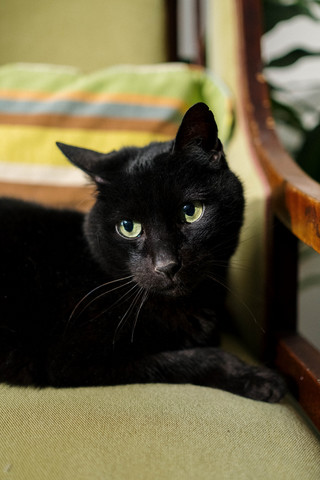 A sleek black cat with a glossy coat, sitting and looking directly at the camera.
A sleek black cat with a glossy coat, sitting and looking directly at the camera.
You might be thinking, “But I’ve seen cats in so many other solid colors!” If black and orange are the only base colors, where do shades like gray, brown, or cream come from?
The answer lies in “dilution genes.” These genes act like filters, modifying the intensity of the base pigments. Imagine them as Instagram filters applied to the initial black or orange “image.”
Solid-colored cats, excluding white, are fundamentally black. However, they may possess a dilution gene that lightens the black pigment to create a range of shades. These diluted black colors include:
- Blue (Gray): A softened, grayish tone of black. Russian Blues are classic examples of solid blue cats.
- Chocolate (Brown): A rich, warm brown. Havana Browns exemplify this chocolate hue.
- Lilac (Lavender): A pale, pinkish-gray.
- Fawn: A very pale, creamy beige.
- Cinnamon: A reddish-brown, similar to the spice.
Cats that are simply “black” lack these dilution genes, allowing their natural black pigment to shine through in its full, undiluted glory. They are the #nofilter of the cat color world! Therefore, genetically speaking, all solid-colored cats (except white) are black cats, with or without color-altering “filter” genes.
The Tabby Enigma: Stripes, Swirls, and Spots
What about solid orange cats? Interestingly, while black can be diluted to gray and other shades, the orange base color has a slightly different dilution outcome. Orange can be diluted to cream, a softer, paler version of orange. However, unlike black cats, a truly solid orange or cream cat doesn’t exist naturally. This is due to the way the tabby gene interacts with orange pigment. Orange cats will always display a tabby pattern, even if it’s very faint.
While cartoon characters like Thomas O’Malley from Disney’s Aristocats might depict solid orange cats, in reality, a cat’s coat cannot be a uniform, pattern-free orange (barring extremely rare genetic mutations). Every orange cat will inherently have a tabby pattern.
Tabby: To Be or Not To Be? That Is Not the Question
So, we’ve established that all cats are fundamentally black or orange based and can have their pigment diluted. Now, let’s add another layer to the complexity: tabby patterns.
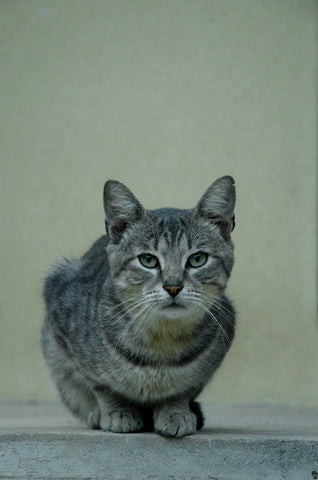 A tabby cat with classic stripes lounging outdoors, showing its distinctive coat pattern.
A tabby cat with classic stripes lounging outdoors, showing its distinctive coat pattern.
Every cat carries either the “agouti” gene or the “non-agouti” gene. The agouti gene is responsible for tabby patterns, while the non-agouti gene suppresses the tabby pattern, resulting in a solid color (in black-based cats). The agouti gene is dominant and more common, which explains why tabby cats are so prevalent. In fact, one could argue that all cats are genetically predisposed to be tabby, but in cats with the non-agouti gene, the tabby pattern is effectively “switched off.”
With just these genetic elements – black vs. orange base color, dilution genes, and tabby or non-tabby – a remarkable array of coat color combinations becomes possible.
Consider a cat with a black base color, a dilution gene for gray, and the agouti gene. This genetic combination results in a gray tabby cat!
Did you know that even black cats can be tabbies? It’s true! Black cats can also carry the agouti gene. While the tabby pattern might not be immediately obvious on a black cat, it can sometimes be subtly visible, especially in kittens or when sunlight catches their fur at the right angle. These are often referred to as “ghost tabbies.”
Tabby cats are iconic figures in popular culture. Think of Garfield or Puss-in-Boots – both are famous orange tabbies!
Intriguingly, even if an orange cat possesses the non-agouti gene, their underlying tabby pattern remains visible. This is because the non-agouti gene only affects black pigment. It has no impact on orange pigment. This genetic quirk reinforces the rule: all orange cats are tabby by default!
Tabby Variations: Stripes, Marbles, Spots, and Ticks
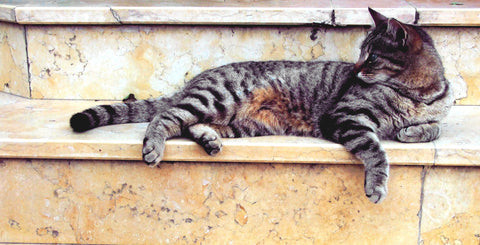 A mackerel tabby cat with distinct vertical stripes, showcasing the classic tabby pattern.
A mackerel tabby cat with distinct vertical stripes, showcasing the classic tabby pattern.
Just as the base colors of orange and black can be diluted into different shades, the agouti gene itself can be further modified to create four distinct types of tabby patterns:
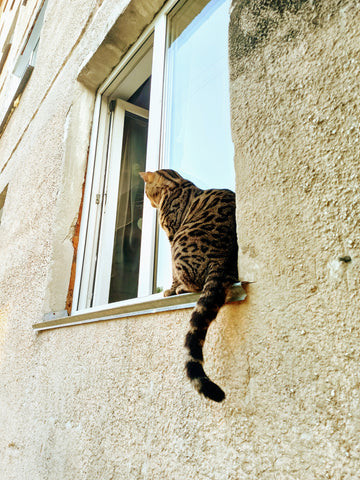 A spotted tabby cat with well-defined spots, resembling a miniature leopard.
A spotted tabby cat with well-defined spots, resembling a miniature leopard.
- Mackerel Tabby: This is the most common tabby pattern, often visualized as the “classic” tabby. It features narrow, vertical stripes running along the cat’s sides, resembling the stripes on a mackerel fish.
- Classic Tabby (Marbled): Also known as “blotched” or “marbled” tabby, this pattern showcases bold, swirling patterns and large blotches on the cat’s sides.
- Spotted Tabby: This pattern features spots of varying sizes scattered across the cat’s body, reminiscent of wild cats like jaguars or leopards. Spotted tabby patterns are prominent in breeds like Bengals and Savannah cats, which have ancestry linked to wild cat species.
- Ticked Tabby (Agouti Tabby or Abyssinian Tabby): The most subtle tabby pattern, ticked tabby coats appear mostly solid at first glance. However, upon closer inspection, you’ll notice that each hair shaft is banded with different colors (agouti hairs). Ticking creates a salt-and-pepper or sand-like appearance. Faint tabby markings may still be present on the face and legs. The Abyssinian breed is the quintessential example of a ticked tabby.
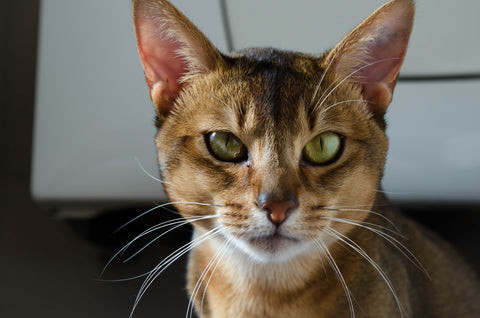 A classic tabby cat with swirling patterns on its side, demonstrating the marbled tabby pattern.
A classic tabby cat with swirling patterns on its side, demonstrating the marbled tabby pattern.
Adding White: Bicolor and Tricolor Cats
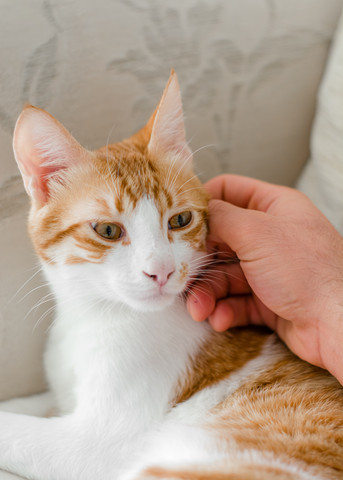 An orange and white bicolor cat, showing a distinct pattern of orange patches on a white base.
An orange and white bicolor cat, showing a distinct pattern of orange patches on a white base.
We’ve covered base colors and tabby patterns. Now, let’s introduce the “masking” gene, which adds splashes of white to many cat coats.
The masking gene essentially “masks” or covers up any underlying color with white, regardless of the cat’s base color or pattern. When the masking gene is expressed only in certain areas of the body, it’s termed “partial masking” or “piebald.” If the masking gene is expressed throughout the entire body, it results in a completely white cat.
Piebald Patterns: Bicolor and Tricolor Variations
A bicolor cat exhibits white fur combined with another color. The colored portions can be black-based or orange-based, diluted or undiluted, tabby or solid. Bicolor patterns are incredibly diverse and beautiful. One common bicolor pattern is the “tuxedo” cat, which is predominantly black with white markings typically on the chest, paws, and sometimes the face. Another variation is the “locket” pattern, where a cat has a small, distinct patch of white, often on the chest.
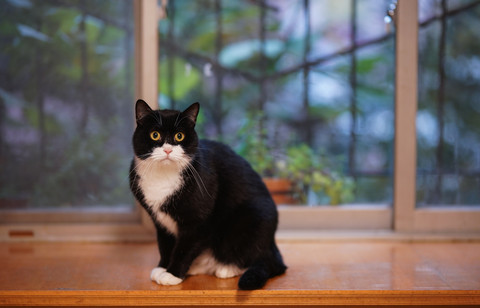 A tuxedo cat with a black coat and white markings on its chest, paws, and face.
A tuxedo cat with a black coat and white markings on its chest, paws, and face.
Tricolor cats, as the name suggests, display three colors: white, orange, and black. Like bicolor cats, the colored areas can also exhibit dilutions or tabby patterns.
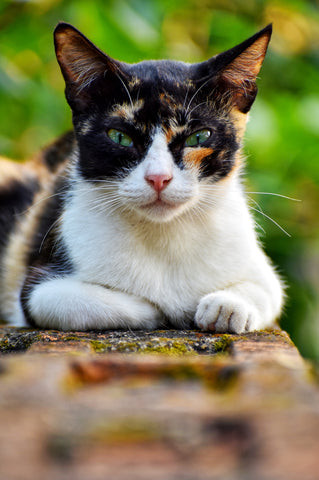 A calico cat with patches of white, orange, and black, showcasing the tricolor pattern.
A calico cat with patches of white, orange, and black, showcasing the tricolor pattern.
Remember, only female cats can naturally be both orange and black. Therefore, tricolor cats are almost exclusively female. Tricolor cats are commonly known as calico cats.
The terms tortoiseshell and calico are often confused. A tortoiseshell cat is any cat with a mixture of orange and black. A calico cat, specifically, must have orange, black, and white. Therefore, all calico cats are technically tortoiseshells, but not all tortoiseshells are calico (tortoiseshells may lack white).
White Cats: Albino vs. Masking Gene
A common misconception is that all white animals are albino. However, most white cats are not albino. What’s the difference?
True albinism is a genetic condition where the body is unable to produce melanin, the pigment responsible for color in skin, fur, and eyes. An albino cat might inherit genes for various colors and patterns, but due to their cells’ inability to produce pigment, these genes are not expressed in terms of color.
Imagine a “paint-by-numbers” kit where the instructions specify various colors, but you have no paint! The resulting picture will be blank, regardless of the intended colors. Albino cats may have some health sensitivities, particularly to sunlight, but are otherwise normal cats and make wonderful companions.
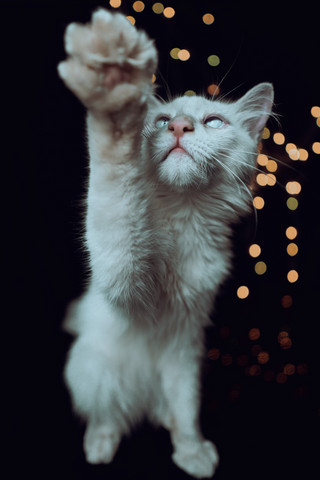 A white albino cat with pink eyes and pale fur, highlighting the characteristics of albinism.
A white albino cat with pink eyes and pale fur, highlighting the characteristics of albinism.
True albino cats are rare. The majority of white cats are white due to the masking gene, the same gene that creates white patches on bicolor and tricolor cats. In all-white cats, this gene is expressed completely, masking all other colors and resulting in a pure white coat.
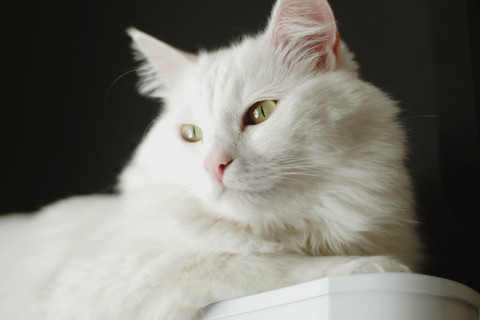 A fluffy white cat with yellow eyes, illustrating a non-albino white coat due to the masking gene.
A fluffy white cat with yellow eyes, illustrating a non-albino white coat due to the masking gene.
Using our paint-by-numbers analogy again, a masking gene white cat is like a picture where the instructions specifically tell you to paint the entire canvas white (perhaps a snow scene). The cat’s genes are instructing it to be white.
How can you tell if a white cat is albino or simply white due to the masking gene? The easiest way is to look at their skin and eye color. A non-albino white cat will often have some pigmentation in their skin (e.g., black spots on paw pads) and colored eyes (e.g., yellow, green, blue). A true albino cat will have completely pink skin and pink or very pale blue eyes due to the absence of pigment.
Pointed Patterns: Temperature-Sensitive Albinism
Beyond the masking gene, there’s another fascinating way cats can have white fur: the “pointed” pattern. This pattern is most commonly seen in Siamese, Burmese, Tonkinese, Himalayan, and related breeds like Ragdolls and Snowshoes.
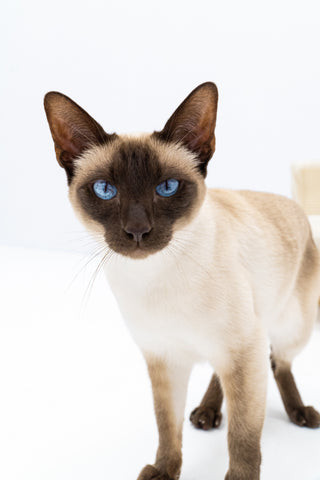 A Siamese cat with a pointed pattern, showcasing dark points on a light body and blue eyes.
A Siamese cat with a pointed pattern, showcasing dark points on a light body and blue eyes.
Pointed cats have a light-colored body with darker “points” – color concentrated on the face (mask, ears), paws, and tail. Interestingly, the white sections of a pointed cat’s coat are not due to the typical masking gene. Instead, the pointed pattern is a form of temperature-sensitive albinism!
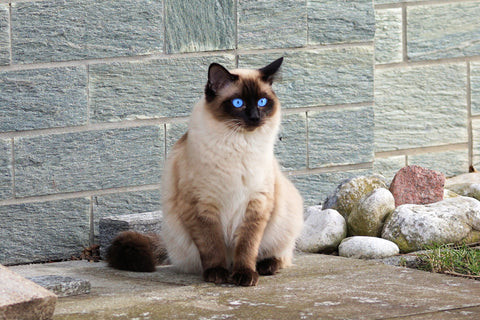 A Birman cat with a pointed pattern, featuring a light body, dark points, and white paws.
A Birman cat with a pointed pattern, featuring a light body, dark points, and white paws.
In pointed cats, the gene responsible for pigment production is temperature-sensitive. In warmer areas of the cat’s body, pigment production is inhibited, resulting in lighter fur. Color develops only in the cooler extremities – the points. This temperature sensitivity also explains why pointed cats often have blue eyes.
Pointed kittens are born almost entirely white. Their points gradually develop color over a few weeks as they grow and their body temperature regulates. Remarkably, if pointed kittens are raised in a very warm environment during their first few weeks of life, they may not develop any points at all, effectively becoming all-white cats due to the temperature-sensitive gene!
Does Coat Color Dictate Cat Personality?
Anecdotes and stereotypes abound linking cat coat color to personality. For example, orange cats are often portrayed as lovable goofballs (think the “one orange brain cell” meme), and tortoiseshells are sometimes labeled as feisty (“tortitude”).
However, these are likely human projections and biases. The association of “tortitude” with tortoiseshells might simply stem from the fact that tortoiseshells are almost always female, and we may stereotype female animals as being more assertive. Similarly, the stereotype of goofy orange cats could be linked to the higher prevalence of males in orange cats, and societal stereotypes about male personalities.
The scientific consensus is that cat coat color is not directly linked to personality. Cat breeds can influence personality traits (e.g., Siamese cats are known for being vocal, Maine Coons for being gentle giants), but coat color alone is not a reliable predictor of temperament. Each cat is an individual, shaped by a complex interplay of genetics, environment, and experiences.
Cat coat colors are a testament to the incredible diversity and beauty of the feline world. The vast array of patterns and shades seems limitless, yet it all originates from just two base colors and a few modifying genes. Next time you’re cuddling your furry companion, take a moment to appreciate the intricate patterns in their fur and marvel at the genetic artistry that makes each cat truly unique and wonderful!

